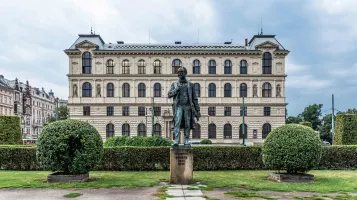History of Czech language
3 July 2023
Knowledge

Czech language, or what the Czech softly call it "Čeština", had been gradually developing and constantly changing before it got its modern shape. Alexandra Baranova, the author of the GoStudy blog, is going to fill us in on it all.
Czech language is a part of the Slavic languages group that also includes the Old Slavic, Bulgarian, Serbian, Croatian, Slovenian, Slovak, Polish and Ukrainian languages. Similarity in writing and pronunciation of many words explains their common descending from the Proto-Slavic language. The speech differences became more obvious after the Slavic people started to settle down in the regions that they occupy ever since.
This language group has three branches: East Slavic, West Slavic and South Slavic. Czech and Slovak languages are included in the "West" branch, while Ukrainian refer to the "East" one. Beginning of the establishment and development of Czech language as an independent unit is considered to be at the end of the first millennium A.D. Significant changes in the language coincided with the key stages of the Czech history.
The Earliest stage: end of the X century - middle of the XII century.
There is no written evidence of this period left. All writing was done in Latin or old Slavic language.
Feudal stage: middle of the XII century - end of the XII century.
During that time first Czech translations of separate words and phrases started to appear. Firstly, people used only Latin alphabet for writing; however, within the XIII century we meet the first digraphs and trigraphs: a sequence of two or three letters that denoted sounds that had no Latin equivalent. For instance, "sh", i.e. modern "š" was written as the combination "ss". The earliest written evidence is considered to be Litoměřice Altarpiece (Czech. Zakládací listina litoměřické kapituly) with two sentences written in Czech language.
"Literary" stage: the XIV century
Literary works of different genres are written in Czech language in the XIV century. "Čeština" gradually appears in the administrative documents as well. Digraphs "ye", "rz", "zz", "ss" continue to be used; whereas letters "i" and "y" are considered interchangeable.
"Hussite" stage: the XV century
Written and oral speech were significantly different that moment: colloquial elements were absent in the written language. A so-called grass-root language was constantly developing in the XV century, thus differences between the written and oral forms were beginning to become less acute.
At the same time, as per the decision of Jan Hus, the church reformer and a rector of the Prague University, a Czech language reform was conducted. He was the first to use the diacritics, known as "Čárka", "hacek" and "kroužek", to make written speech easier. Long vowels were denoted with "Čárka" and "kroužek", while combination of several consonants were replaced with "hacek". There was only one digraph left to denote the letter "ch".
"Humanistic" stage: the XVI century - beginning of the XVII century
A new round of the history of Czech language development was marked with its active use in the scientific society. Those humanists who spoke "Čeština" made great effort for its improvement in terms of grammar and vocabulary.
After the invention of the book printing, the Czech spelling was influenced greatly by the Unity of the Brethren (czech. Jednota bratrská). Colon, dot, exclamation and question marks appeared in the punctuation system, while morphology was characterized by the establishment of the difference between animate and inanimate masculine nouns. The next step to the modern form of Czech language was the publishing of a textbook: a work of Vavrinec Benedikt of Nedožery "Grammaticae Bohemicae ad leges naturalis methodi conformatae, et notis numerisque illustratae ac distinctae, libri duo, 1603". Jan Blahoslav, a writer-humanist and a translator, attempted to create the first systematic Czech grammar in 1571. However, his version of the "Czech grammar" is considered unsufficiently developed.
The reference of the written literary speech at that time was a new translation of the Bible (Czech. Bible kralická).
Baroque stage: the XVII century - end of XVIII century
The period of prosperity of Czech language changed into its decay resulting from the annexation of Bohemia to the possessions of the Hapsburg Empire. Lose of independence resulted in German language, or "NĚMČINA" in Czech, becoming the official state language. German language conquered the culture space: it was spoken by aristocrats, books as well as scientific works were written in it. Germanisms gradually appeared in Czech language which was actively used by ordinary people and among emigrants abroad.
Renaissance stage: end of XVIII - the XIX century
Formation of the modern Czech Republic started at that time and was accomplished by the renaissance of Czech language. Writers, historians, teachers, scientists, translators and outstanding artists like Josef Jungmann, Božena Němcová, Magdalena Dobromila Rettigová, Jan Evangelista Purkyně and others were the ideological inspirers and key figures at that time. All of them promoted enlarging the vocabulary of Czech language and cleaning it from Germanisms. Josef Dobrovský played an important role in the history of Czech language. He published a series of sketches where formulated the main grammar rules of the "Čeština", in particular, divided verbs into classes. First half of the XIX century was characterised by the publishment of the five-volume Czech-German Dictionary by Josef Jungmann, and the first Czech encyclopedia saw the light in the 60s-70s.
Modern stage: the XX century - present days
Starting with the 40s of the XIX century formal Czech language was no longer a privilege of the upper class. Archaisms were gradually taken out of use, number of complex syntax construction was reducing and the language has more and more vivid and natural shape.
Jan Gebauer published his "Historical grammar of the Czech language" in 1902, where he described the main morphological rules. Czech language received its official status in 1920. German occupation during the Second World War threatened to introduce Germanisms again into the active vocabulary of Czech language; however, there were no any significant changes to the language.
Czech language suffered several "home" reforms within a century; the latest version of the spelling rules was established by the Institute of the Czech Language of the Academy of Sciences in 1993. Due to the increased popularity of English and its implementation into the school education, "Čeština" has been enriched with Americanisms and Anglicisms. There are certain rules for pronunciation and declension of foreign words.
As any "live" language, Czech language is gradually changing. Nowadays, the most wide-spread form is "obecná čeština", a language form for everyday communication. It does not have any complex constructions specific for the "official" Czech language, that may sound strangely and unusually. Linguists believe that elements of the "general Czech language", vice versa, are gradually soaking into different literary genres.
There are several levels of "general Czech language" that can be learned by a foreigner. They correspond to the European system CEFR and are marked as А1, А2, В1, В2, С1, С2. It is enough to pass first three levels for conducting a simple day-to-day conversation, while levels B2-C2 assume good command of the language for study or work.
Despite the similarity of Czech language with other Slavic languages, it is not that easy to learn it as it seems from the first sight.
It is necessary to:
"spend a lot of time on grammar,
practice writing and listening on a regular basis,
read books in Czech,
constantly try to speak with native speakers,
find the best way of learning language personally for you,
have consultations with professional teachers."
You can fully acquire modern Czech language by following the rules specified above.
Related articles

Knowledge

